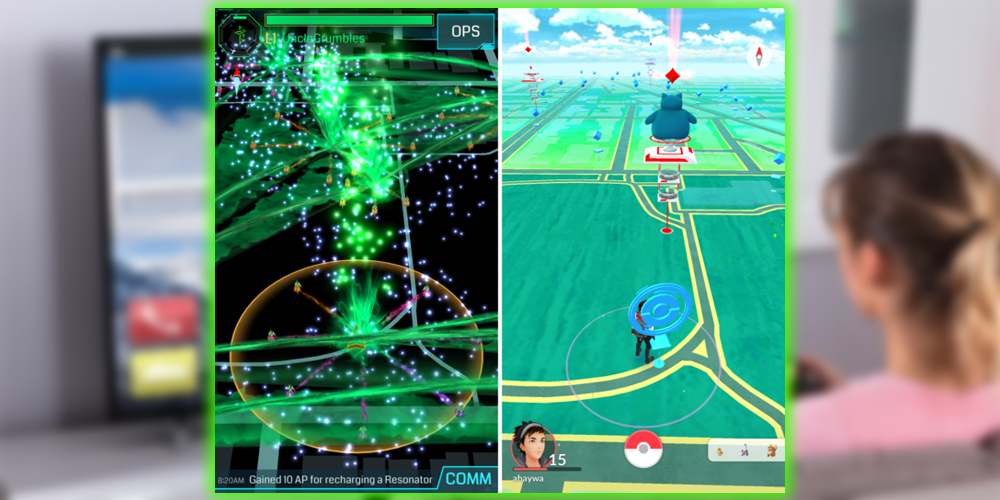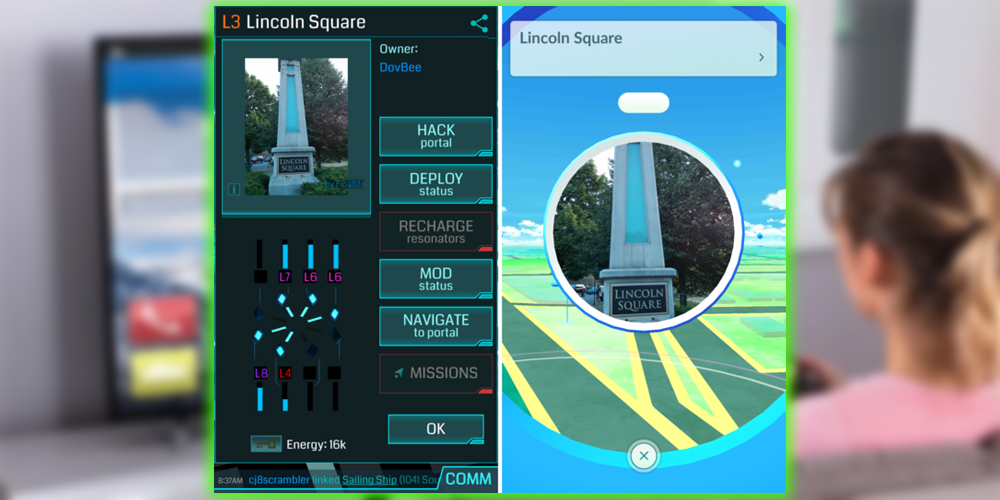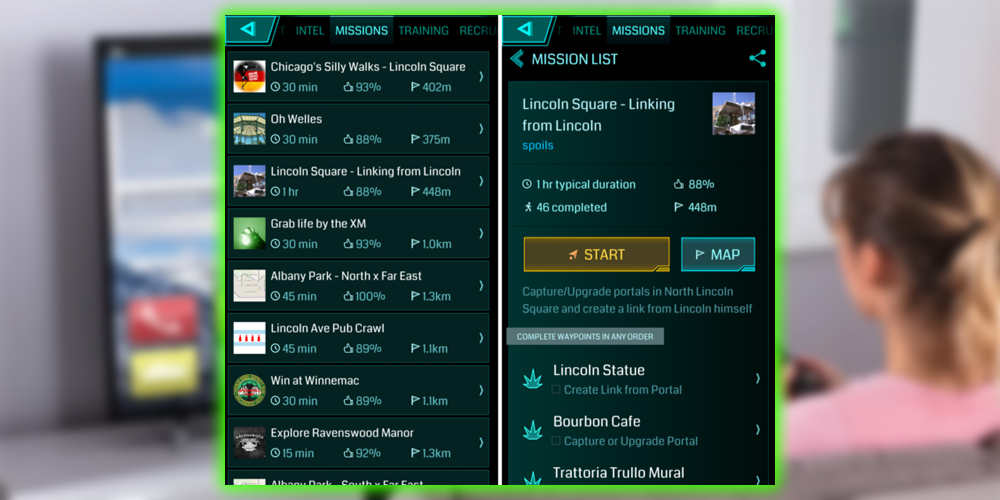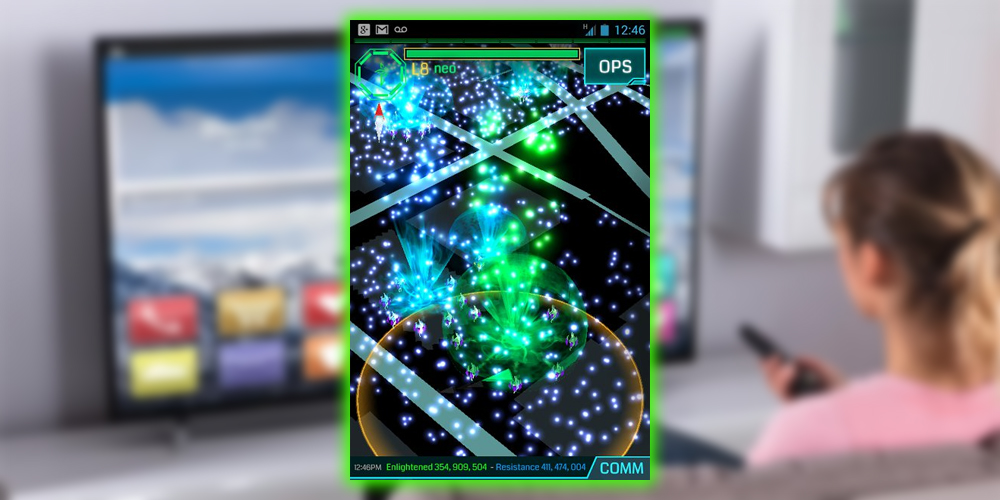What is Ingress?
Unlike the cuddly colorful Pokémon Go, Ingress has a dark science fiction edge. Dropping players into a fictional world where scientists have discovered a powerful particle called Exotic Matter XM. It hails from the mysterious alien Shapers, apparently. Still, people around the fictitious world are divided on whether or not we should mess with it.
The Enlightened, that’s the green team, believe that the XM will advance human capabilities. And trigger our next evolution; they fight for that vision. Meanwhile, the Resistance, the blue team, wants nothing to do with the XM. Believing the human race will be enslaved and diminished if they embrace the mysterious material. As such, both squads battle to establish control fields worldwide by linking portals on the map.
That’s just the starting point for the story; through YouTube videos, and other status reports. Niantic has built an ongoing narrative about the war between sides and the hidden motivations behind each. If you want it, there’s a lot to dig into, unlike the story-free Pokémon Go. Or you can play Ingress for fun and ignore the rest. Niantic also holds significant in-game XM Anomaly events from time to time. Including the just concluded Aegis Nova, wherein portals open up in specific worldwide locations. And challenge players to control most of them. Live events are also held during these quarterly challenges; different story threads usually come out.
How They’re Similar
Both games occur in the world around you, with the primary interface derived from Maps and nodes placed in hotspots. Statues, signs, buildings, and sometimes stores serve as these outposts in the world;. However, there seems to be a lot more on the Ingress map; Niantic trimmed the list significantly for Pokémon Go.

As you are near each location, called a portal in Ingress or a Poké Stop in Pokémon Go. You can activate it to generate items to help further your mission elsewhere in the game. The same five-minute wait between single-spot activations applies in both games. So you can’t just sit in one place and constantly generate an inventory.
So, the idea of team-based gameplay holds true across both games. Ingress has two factions battling for control of nodes and then linking them together to create control fields. At the same time, Pokémon Go lets its three-player squads fight over control of nearby Pokémon gyms in the world. There’s a lot more to the team play in Ingress than in Pokémon Go so far, however.
How They Differ
In fact, there’s a lot more to Ingress, period. Part of that is undoubted because Ingress has been live for nearly four years, including the initial beta period. Pokémon Go has been around for weeks. Ingress has had more time to evolve upon its initial design and implement new features. However, Pokémon Go is a much more streamlined game, likely because the franchise is meant to appeal to all ages. At the same time, Ingress is clearly targeted toward older players. Ingress has a chat between players among teams. In contrast, Pokémon Go has no communication, making it easier to avoid abuse and keep kids safe.
With Pokémon Go, the Poké Stops are just there to feed you items; that’s their sole purpose. Conversely, Ingress makes each portal a battleground; there are many moving parts to taking over an outlet for your faction. Players can install up to eight different resonators on each portal. Each has a strength level that can be upgraded or replenished when weakened.

Supporting your team mates
To take a portal away from the other team. You’ll need to fire off XM bursts to weaken the resonators and try to remove them from the portal. On the other hand, if a portal is already under your faction’s command. You can help reinforce it when walking by. That’s a nice perk that Ingress offers over Pokémon. Letting you support your team to ensure that your neighborhood’s hotspots stay under your command. Rather than the constant back-and-forth approach of claiming gyms in Pokémon Go. Filling support slots in gyms could be Pokémon’s analog here, but it’s a simplified approach.
Ingress doesn’t have head-to-head battles like in Pokémon Go. Nor is there anything similar to capturing monsters or viewing anything via augmented reality moments. The two games share the same core play approach but vary quite a bit in theme execution. Pokémon Go is streamlined and accessible, making monster catching its primary goal. Ingress, on the other hand, is a heavily driven menu. And is all about furthering the aims of your chosen faction.
Should You Play?
Ingress is free, so you might as well give it a shot. Its servers aren’t being crushed like Pokémon Go’s are. So Ingress could be a welcome respite when the other game doesn’t work. It’s a challenging game to get into, however. The Ingress interface is overloaded and tough to understand, the menus are densely filled. And even the text-heavy tutorials don’t do enough to ease you into the experience.
Part of the frustration comes from the fact that progression is slower than in Pokémon Go. And that your items and abilities are fragile early on. Other people playing for years have high-level characters with powerful attack items. While your early blasts do nearly nothing to nearby portal resonators. Ingress feels like the kind of game you need a hardened friend to help you understand and advance through. Without a guiding hand, it feels a bit impenetrable.
That’s a big contrast from Pokémon Go, which is super streamlined and pretty easy to grasp. Even if a lot of the minor details aren’t explained well enough, if at all. Pokémon Go is ultra-accessible and meant for everyone to enjoy with little trouble. At the same time, Ingress requires much more commitment and some perseverance.

The Meets
While that makes early Ingress play a struggle. It means potentially greater rewards and fulfillment for players who stick with the experience. Millions of players and plenty of die-hards take part in the events and meet-ups to debate the story threads online. In other words, if you’re looking for a fictional, interactive rabbit hole to explore, Ingress can offer that.
Pokémon Go doesn’t have any of that so far. It’s a reliable cycle of capturing monsters, evolving them, triggering Poké Stops, and battling over gyms. Niantic will likely add more social elements, including trading, perhaps making the team play a proper focus. Events also seem a certainty, but that stuff may take time. It’s doubtful that Pokémon Go will ever sacrifice its essential accessibility to boost depth.
Ingress might not be the headline grabber that Pokémon Go is right now. Still, as of January 2016, it had amassed more than 14 million downloads. More than a quarter of a million players are devoted or curious enough to attend Niantic’s live events. It’s a big game with hardcore fans; if you’re looking for something more prosperous and complex than Pokémon Go. You have some patience, then Ingress might be what you need.
Bonus: For Lapsed Ingress Players
If you played Ingress in the early days but fell off the bandwagon. Is there any reason to loop back on it now? Possibly! In addition to the ongoing narrative developments and frequent in-game live events, there’s one prominent feature you might have missed. Ingress now has a Missions tab that can direct you toward things to do.

Essentially, missions are sequences of location objectives that help guide you around nearby landmarks. Tasking you with visiting multiple portals, creating links or fields, and even hunting for information in the world around you. Agents at level 7 or above can create their own missions and submit them for inclusion, meaning the community creates little challenges to keep everyone entertained defending/taking portals.
It’ll save you some meandering and maybe even expose you. To more of your city in the process, which is always a plus. So, Ingress added Android Wear support the previous year. So if you’re wearing a watch playing. You can perform basic actions right from your wrist rather than pulling out your phone. FevGames has a more extensive update-by-update breakdown of how Ingress has evolved, in case you’re looking for the tiniest details on what’s changed over time.















